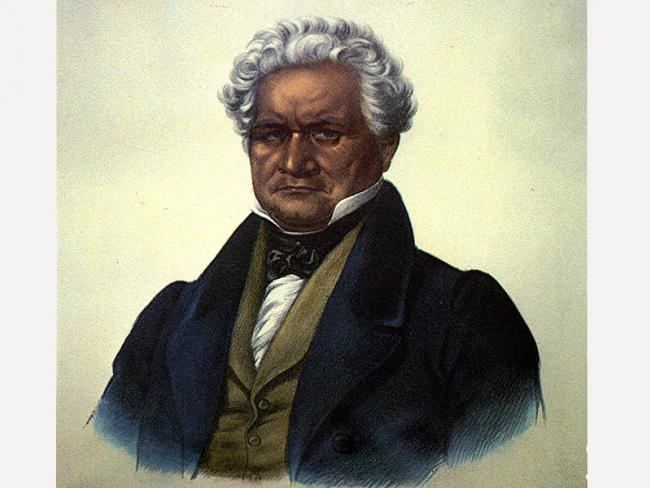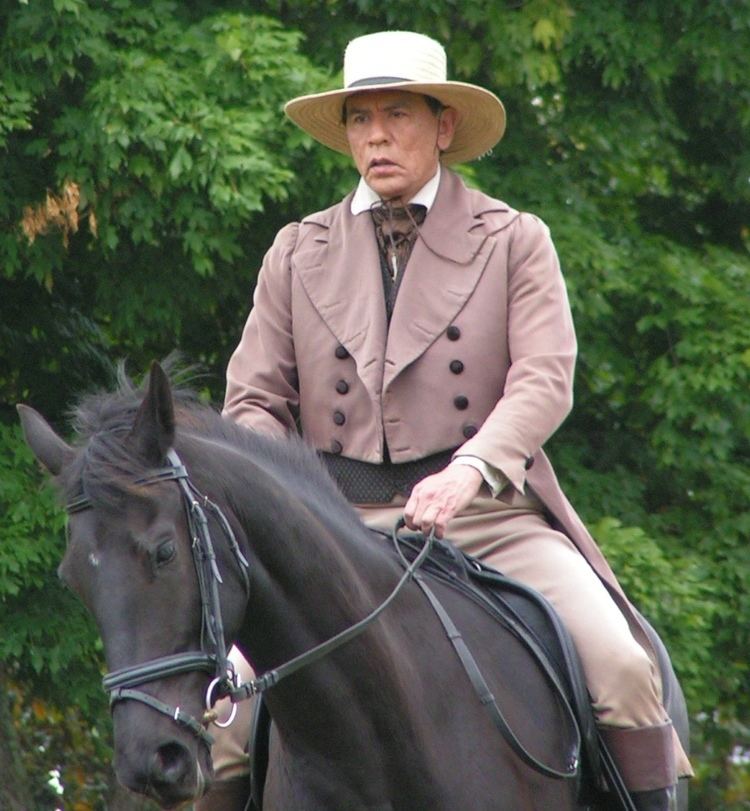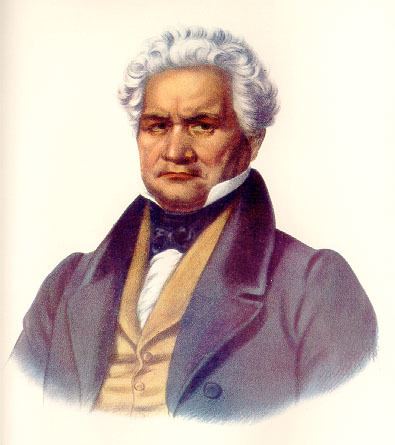Children John Ridge Citizenship United States Spouse Sehoyah (m. 1792) | Ethnicity American Indian Role Leader Nationality American Name Major Ridge Grandchildren John Rollin Ridge | |
 | ||
Similar People John Ridge, John Ross, John Rollin Ridge, Sequoyah | ||
Major Ridge, The Ridge (and sometimes Pathkiller II) (c. 1771 – June 22, 1839) (also known as Nunnehidihi, and later Ganundalegi) was a Cherokee leader, a member of the tribal council, and a lawmaker. As a warrior, he fought in the Cherokee–American wars against American frontiersmen. Later, Major Ridge led the Cherokee in alliances with General Andrew Jackson and the United States in the Creek and Seminole Wars.
Contents

Along with Charles R. Hicks and James Vann, Ridge was part of the "Cherokee triumvirate," a group of younger chiefs in the early nineteenth century Cherokee Nation who supported acculturation and other changes in how the people dealt with the United States. All were of mixed race and had some exposure to European-American culture, but identified as Cherokee. Ridge became a wealthy planter, slave owner and ferryman.

Under increasing pressure for removal from the federal government, Ridge and others of the Treaty Party signed the controversial Treaty of New Echota of 1835. They believed removal was inevitable and tried to protect Cherokee rights. It required the Cherokee to cede their remaining lands in the Southeast to the US and relocate to the Indian Territory. Opponents protested to the US government and negotiated a new treaty the following year, but were still forced to accept removal.
Early life
Ridge was born about 1772 into the Deer clan of his mother, Oganotota (O-go-nuh-to-tua), a Scots-Cherokee woman, in the Cherokee town of Great Hiwassee, along the Hiwassee River (an area later part of Tennessee). His father was believed to be full-blood Cherokee. His maternal grandfather was a Scots trader who returned to Europe and left a Cherokee wife and daughter behind in America.
He was the third son born, but the first to survive to adulthood. He had two younger brothers, one of whom became known as David Uwatie (or Watie). From his early years, Ridge was taught patience and self-denial, and to endure fatigue. On reaching the proper age, he was initiated as a warrior. The Cherokee believed that a man's achievements as a warrior were a sign of his spiritual power and part of his leadership.
Until the end of the Cherokee–American wars, the young man was known as Nunnehidihi, meaning "He Who Slays The Enemy In His Path" or "The Pathkiller" (not the same as the chief of the same name). Later he was named Ganundalegi (other spellings include Ca-Nun-Tah-Cla-Kee, Ca-Nun-Ta-Cla-Gee, and Ka-Nun-Tah-Kla-Gee), meaning "The Man Who Walks On The Mountain Top." White men knew him by the simplified English name, "The Ridge".
Marriage and family
In 1792 Ridge married Sehoya, also known as Suzannah Catherine Wickett, a mixed-blood Cherokee of the Wild Potato clan. Her name was also spelled Sehoyah; she was the daughter of Kate Parris and Ar-tah-ku-ni-sti-sky ("Wickett"). The couple had several children, including John Ridge. They sent him in 1819 as a young man to Cornwall, Connecticut to be educated in European-American classical studies at the Foreign Mission School.
After the Cherokee–American wars, the Ridges lived in Oothcaloga, near what developed as the modern city of Calhoun, Georgia. About 1819, they moved near the Cherokee town of Chatuga (modern-day Rome) at the confluence of the Oostanaula and Etowah rivers, which forms the Coosa River. Ridge acquired 223 acres that fronted on the Oostanaula River, upstream of the confluence. Starting with a log dogtrot house on the property, Ridge expanded the house to a two-story white frame house with extensions on either end. Ridge used enslaved African Americans to work the cotton fields on his plantation. Nearby was the home and plantation of Ridge's protégé, John Ross.
Ridge had no formal education and could neither read nor write. But he was known as a noted orator and dynamic speaker. He appreciated the value of education and believed that the Cherokee must learn to communicate with European Americans and to understand their ways in order to survive as a nation. He sent his son John to a mission boarding school at Springhill.
Young warrior
Besides small raids and other actions, Nunnehidihi took part in the attack on Gillespie's Station and in Watts' raids in the winter of 1788–1789; the attack on Buchanan's Station in 1792; the campaign against the settlements of Upper East Tennessee in 1793 (that resulted in the massacre and destruction of Cavett's Station); and the so-called "Battle of Hightower" at Etowah. (Before the 1793 campaigns, he had taken part in a horse-stealing raid against the Holston River settlements, where two pioneers were killed.)
With the massacre at Cavett's Station, a personal feud developed between The Ridge and Chief Doublehead. The latter had promised to spare the post if the three white men who lived there surrendered. But, after the men agreed to surrender, Doublehead changed his mind and ordered that all the inhabitants be killed, including thirteen women and children. This act disgusted The Ridge, who felt it dishonored the tribe. Frontiersmen pursued Ridge's band, catching them at Coyatee (near the mouth of the Little Tennessee River). They killed several leading Chickamauga Cherokee and wounded others, including Hanging Maw, the chief headman of the Overhill Towns.
At age 21, Nunnehidihi was chosen as a member of the Cherokee Council. He proved a valuable counselor, and at the second session proposed many useful laws. After the Cherokee–American wars, he changed his name to Ganundalegi, which in English was translated as "The Ridge".
In 1807, Chief Doublehead was bribed by white speculators to cede some Cherokee communal land without approval by the Cherokee National Council. The Council determined this to be a capital crime against the nation, and directed Ridge, James Vann, and Alexander Sanders to execute Doublehead. (Vann became too drunk to participate. The other two men used guns, knives, and a tomahawk to kill the old chief on August 9, 1807 at the Hiwassee Garrison in Tennessee).
Shortly before the War of 1812, Shawnee chief 'Tecumseh' and his brother, Tenskawatawa (also called "The Prophet"), came south to recruit followers from other tribes to prevent the sale of their hunting grounds to white immigrants. Tecumseh urged his listeners to reject the agrarian life and take up weapons to defend their land. Ridge attended as an observer when Tecumseh spoke to the Creek living nearby. Ridge reportedly confronted Tecumseh after the meeting and warned that he would kill Tecumseh if he tried to spread that message to the Cherokee.
Later life
Ridge acquired the title "Major" in 1814, during his service leading the Cherokee alongside the United States General Andrew Jackson at the Battle of Horseshoe Bend during the Creek War against the Red Sticks. This was a civil war within the Creek Nation between the Upper Towns and Lower Towns, who differed in their interaction with European Americans and hold on tradition. Ridge had joined the campaign as an unofficial militia lieutenant. (Jackson was involved with the larger War of 1812 against Great Britain.) Ridge used Major as his first name for the rest of his life. He also served with Jackson in the First Seminole War in 1818, leading Cherokee warriors on behalf of the US government against the Seminole Indians. His war achievements added to his stature among the Cherokee.
After the war, Ridge moved his family to the Cherokee town of Head of Coosa (present-day Rome, Georgia). He developed a plantation, owned 30 African-American slaves as laborers, and became a wealthy planter. The plantation consisted of nearly three hundred cleared acres whose main cash crops were corn, tobacco and cotton. He built his house. Major Ridge also developed and owned a profitable ferry that carried wagons and their teams across the Oostanuaula River. as another business, Ridge founded a trading post in partnership with George Lavender, a white man; the post provided staples and luxury European-American goods such as calico and silk fabrics.
In 1816, Andrew Jackson tried to get the Chickasaw and Cherokee to sell their lands in the Southeast and move west of the Mississippi River. He was rebuffed by most of the Cherokee chiefs at a council in Mississippi. They told him that he must meet with Chief Pathkiller at a Cherokee council in Turkeytown.
Cherokee removal
Ridge had long opposed U.S. government proposals for the Cherokee to sell their lands and remove to the West. But, Georgia efforts to suppress the Cherokee government and the pressure of rapidly expanding European-American settlements caused him to change his mind. Advised by his son John Ridge, Major Ridge came to believe the best way to preserve the Cherokee Nation was to get good terms from the U.S. government and preserve their rights in Indian Territory. On December 29, 1835, Ridge made his mark on the Treaty of New Echota, which ceded the remainder of Cherokee tribal land east of the Mississippi River for land in Indian Territory, to be supplemented by the payment of annuities for a period of time, plus support from the government in terms of supplies, tools and food. The tribe was bitterly divided over this decision. Reportedly, Ridge said as he finished, "I have signed my death warrant."
The National Party of Chief John Ross and a majority of the Cherokee National Council rejected the treaty, but it was ratified by the US Senate. The next year Ross negotiated changes with the US government, but essentially Cherokee removal was confirmed.
Ridge, his family, and many other Cherokee emigrate to the West in March 1837. The treaty had been signed in December 1835 and was amended and ratified in March 1836. Georgia put Cherokee lands in a lottery and auctioned them off before the Cherokee removal date; settlers started arriving and squatting on Cherokee-occupied land. Georgia supported the settlers against the Cherokee. After 1838, the US government forcibly rounded up the remaining Cherokee (along with their slaves) on tribal lands. They were the last people to make the journey that became known as the "Trail of Tears," during which nearly 4,000 Cherokee died.
Accompanied by his wife, daughter, and one of son John's children, Major Ridge traveled by flatboat and steamer to a place in Indian Territory called Honey Creek, near the Arkansas-Missouri Border. The land Ridge had chosen was fifty miles from the territory assigned to the Cherokee. He no longer wished to live among his people. His son John Ridge and Major Ridge's cousin Elias Boudinot followed six months later.
Execution
In the West, the Ross faction blamed Ridge and the other signers of the Treaty of New Echota for the 4,000 deaths along the trail in the Removal as well as the loss of communal lands. In June 1839, Major Ridge, his son John, and nephew Elias Boudinot, were executed in accordance with the Cherokee Blood Law by Cherokee of the Ross faction. They tried to kill Elias' brother Stand Watie, but he survived. Other Treaty Party members were later killed, starting a wave of violence within the nation.
Among Ridge's killers was Bird Doublehead. Ridge had killed his father Chief Doublehead under orders by the National Council. Another of his killers was James Foreman, Bird's half-brother. In 1842 Stand Watie, Ridge's nephew, killed Foreman. In 1845 opponents killed his younger brother, Thomas Watie. The cycle of retaliatory violence within the Cherokee resulted in the deaths of all the other Watie family males of that generation. Stand Watie survived the violence of the 1840s, when the Cherokee conflict descended into virtual civil war. In the 1850s, Watie was tried in Arkansas for Foreman's murder but was acquitted on grounds of self-defense; he was defended by his brother Elias' son, Elias Cornelius Boudinot.
Tribal divisions were exacerbated by the outbreak of the American Civil War. Many Cherokee supported the Confederacy, despite the Southern governments having pushed them out. The Confederacy officials now suggested they would recognize an independent Indian state if successful in creating an independent nation. Stand Watie served as Principal Chief (1862-1866) of the pro-Confederate Cherokee after Ross and many Union-supporters withdrew to another location. He served as a Confederate general and was the last to surrender to Union troops.
Burial
Ridge and his son John are buried in Polson Cemetery in Delaware County, Oklahoma. After his nephew Stand Watie died later of natural causes, he was buried near them.
